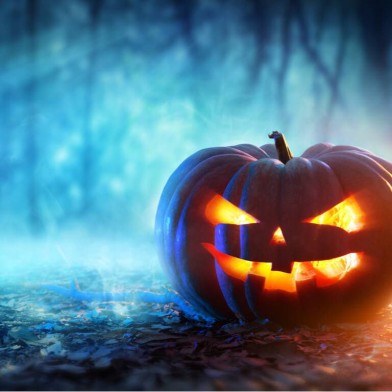In countries with an Anglo-centric tradition, Halloween has become a commercially driven occasion to think about death, albeit in a 'cheap thrills' kind of way. In Southeast Asia, things are somewhat different. Robert Bociaga discovers that the obsession with the afterlife seems to have no boundaries.
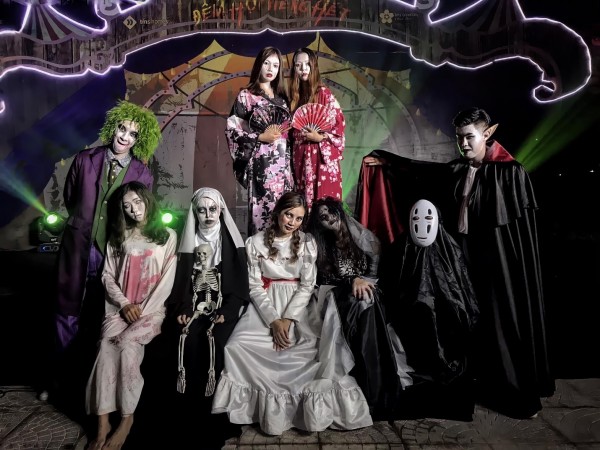
Halloween enthusiasts in Vietnam get ready for celebrations at Yun Cosplay in Hanoi / photo Tran Ngoc My
In the Buddhist cultures of Southeast Asia, Japan and China, where the dead are cremated, corpses play a role in religion, literature, and art not seen in other parts of the world.
“The mummies of monks and those who died unnatural deaths are held in glass coffins for people to view and offer gifts”, writes Justin Thomas McDaniel, author of Wayward Distractions, a detailed examination of his studies into Buddhist practices in Thailand. “Also, the practice of meditating over the dead body is often cultivated in the temples to understand the impermanency of life."
In addition, many people continue the tradition of making ghost dolls which are sculpted out of clay into small human figures to contain one's spirits and serve as a protection.
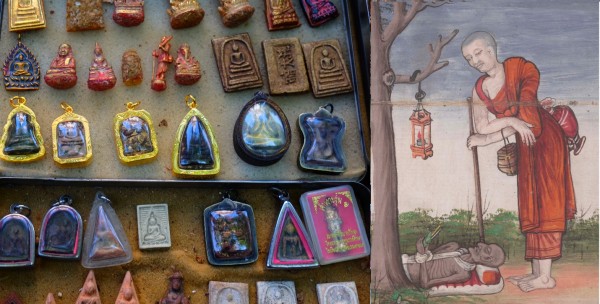
Amulets & a Monk meditating on a corpse in the Phra Malai Klong Suat Manuscript / photo Justin Thomas McDaniel
The Buddhist stories underpinning those beliefs on death and ghosts circulated throughout most of the region for generations. However, for a growing number of people Halloween has become the most anticipated holiday in October.
In Vietnam's major urban centres, on the last day of the month, people usually rush to the streets to hang out at night, dressed in their masks and costumes.
"Last year, due to Covid, people celebrated online by gathering on Zoom, or in bars with under 10 people allowed," says Tran Ngoc My, a costume designer from Hanoi. As a result, face masks were an indispensable part of the costume, for those who braved the bars.
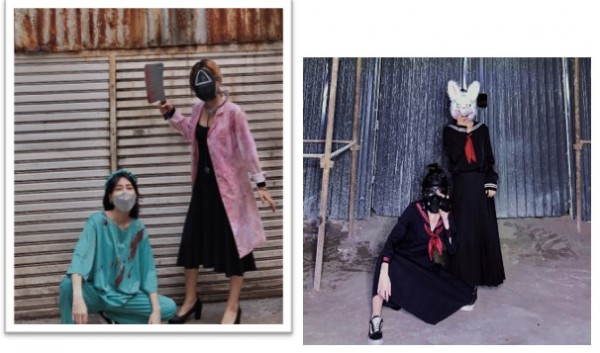
Costumes go hand in hand with face masks in a Vietnamese Halloween/ photo Tran Ngoc My
The Vietnamese have their own annual holiday to remember the deceased. Vu Lan, or the Hungry Ghost Festival, is celebrated in midyear and is known as a time of forgiveness. Originating from Taoist and Buddhist thought, the festival is a chance for those spirits to leave the gates of hell, visit the living and reincarnate.
"It's completely different from Halloween," Tran Ngoc My explains." We make offerings for the lost souls that can otherwise curse bad luck upon us." Halloween, on the other hand, is enjoyable, because "people turn into ghosts, and have as much fun as Westerners," she says.
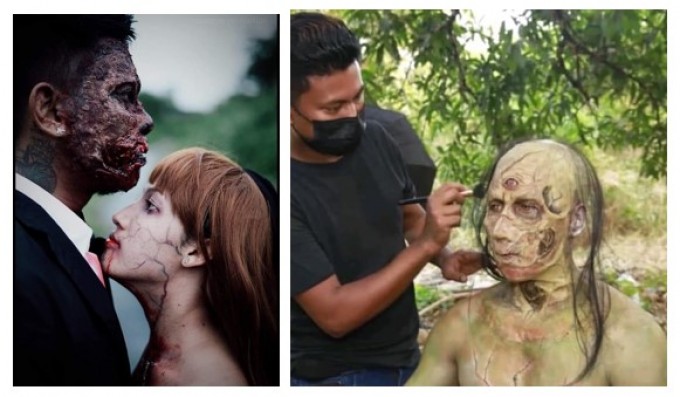
Zaw Zaw Myo Myo's photos of his designs: a Halloween couple and a three-eyed monster.
For Zaw Zaw Myo Myo, a special effect artist, there is not much fun this year. Born in the Myanmar city of Myeik, he moved to Thailand and then to Yangon in his home country to learn the craft of creating the masks and costumes of various creatures.
He lets his imagination soar while working on the horror art, but after the military junta in Myanmar limited the public celebration of Thandigyut, a religious festival of lights commemorating the Buddha’s descent back to earth, this year “just a few decided to celebrate Halloween in the privacy of their homes,” he says.
On the other hand, there are countries in Asia where the celebration of Halloween is discouraged by religious authorities and may require prior approval if held publicly.
In Malaysia, Halloween is seen as a Christian festival of the dead and against Islamic teachings. Therefore, the country’s National Fatwa Council advises Muslims to remember the dead by reciting prayers and reading the Koran.
However, before the pandemic, Malaysia's business sector turned the day from an unpopular and constrained event to one promoted by shopping malls and embraced by many restaurants and bars.
Nevertheless, “The costume party is celebrated by adults on a small scale, as a way to liven up the workplace,” says Faruq Kilau from Kuala Lumpur. “Malaysians who celebrate it are from major cities and culturally adaptive”.
In Indonesia, too, Halloween is not given much attention due to prevailing Islamic traditions. The country’s indigenous culture is, however, rich in its own beliefs about death and supernatural calamities invading the world of humans.
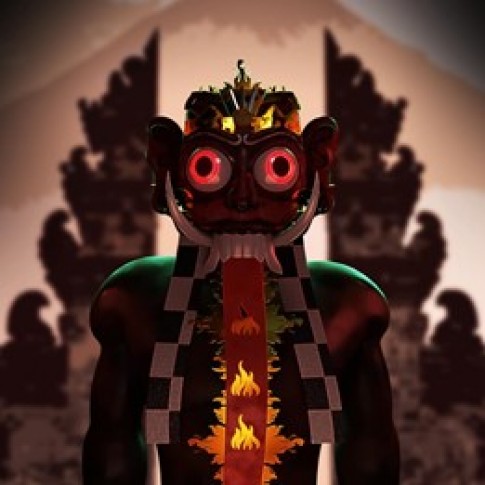
Bali's mythological Leyak, designed using 3D software / photo Reinnard Bartholius
Reinnard Bartholius, based in Indonesia’s Tangerang city close to Jakarta, does not celebrate Halloween. The 23-year-old ethnic Tionghoa, had, however, inspired himself with the story of the leyak, a mythological figure, known in the folklore of Bali as a flying head with entrails.
As a 3D artist, he drew a multi-dimensional picture of the creature to partake in the non-fungible token (NFT) community’s Halloween contest. “It is related to my childhood memory,” he adds. “A leyak that goes around and eats people at night makes me scared until now”.
Putri Prihatini from the Indonesian island of Borneo echoes his view on Halloween. “It is a product of popular culture,” the Balikpapan city-based blogger says. “I can, however, understand the sentiments toward the deaths and scary things.”
“To me, even as a person born and raised in an urban area and not involved in many of the cultural practices, I still think that ghosts and supernatural are not something to be dismissed because we can’t see them,” she comments. “There are many fascinations around this subject, as it has a big impact on our life, and this makes death- or ghost-related traditions revered.”
She names the concept of “Sandhya Kala” anchored in the Javanese culture as an example of a belief similar to those in Halloween. According to it, ghosts might kidnap children during sunset when the door to the world of the spirits is open.
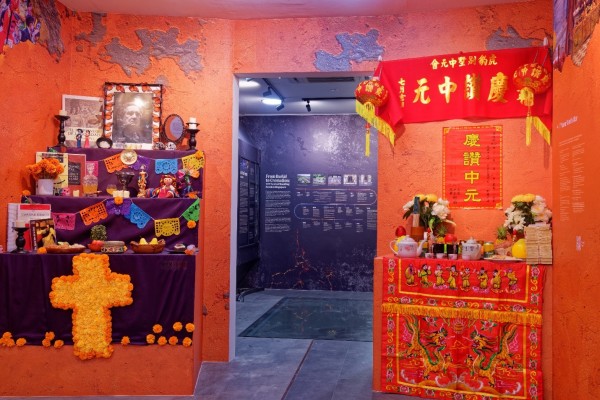
Day of the Dead and 7th Lunar Month altars at Singapore's Haw Par Villa. / photo Journeys Pte Ltd
Importantly, in spite of the decline in the practice of indigenous celebrations across the country, some communities reinvent old myths to suit the current needs. In the effort to curb the spread of Covid, a neighbourhood in Indonesia’s Java province reportedly deployed a group of “ghosts”, known locally as “pocong”. Wrapped in white cloth resembling corpses in burial shrouds, the patrollers were scaring people into staying at home.
Also, while Indonesians do not give sweets to children knocking on their doors, many in rural areas bang pots, wood and utensils to ward off an unwelcomed ghost from bringing calamities.
Looking back, Halloween used to have strong religious affiliations. It is believed that with the spread of Christianity in Europe the church replaced the ancient Celtic festival with the All-Saints Day.
In order to explore the perspectives on death and the afterlife across a multitude of cultures, Singapore’s Haw Par Villa recently curated a museum of the underworld that incorporated the 10 Courts of Hell. They decided to cover not just the Chinese afterlife, but comparative religions.
“Art certainly can help, but providing knowledge, deeper insights and understanding of how our views of the afterlife evolved is also crucial,” says Jeya Ayadurai, its director. “Religions have significant commonalities that are often ignored. Most also espouse a belief in the afterlife, the principle of ‘cause and effect’, and the concept of judgement on the life one had led.”
But, why do we ponder whether we can live on in a metaphysical way?
Many argue that at the root of our fascination with death is clinging to life.
“After all, death and the afterlife are topics relevant to all of humanity,” Jeya Ayadurai says.
- Asia Media Centre
